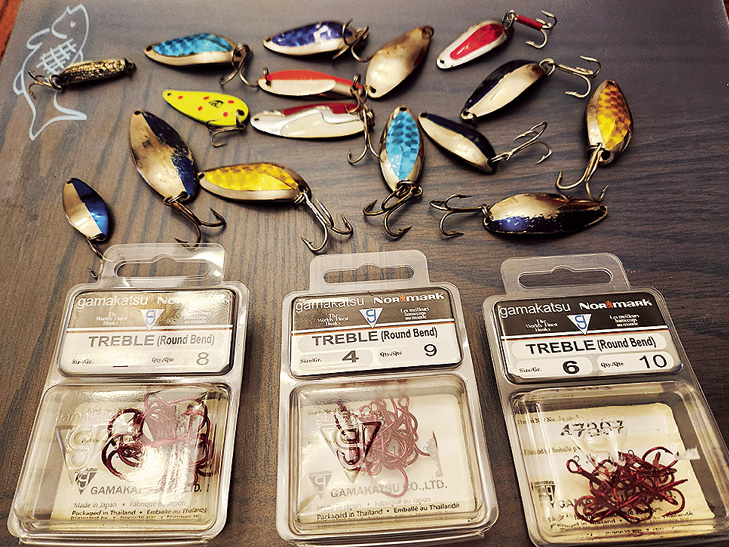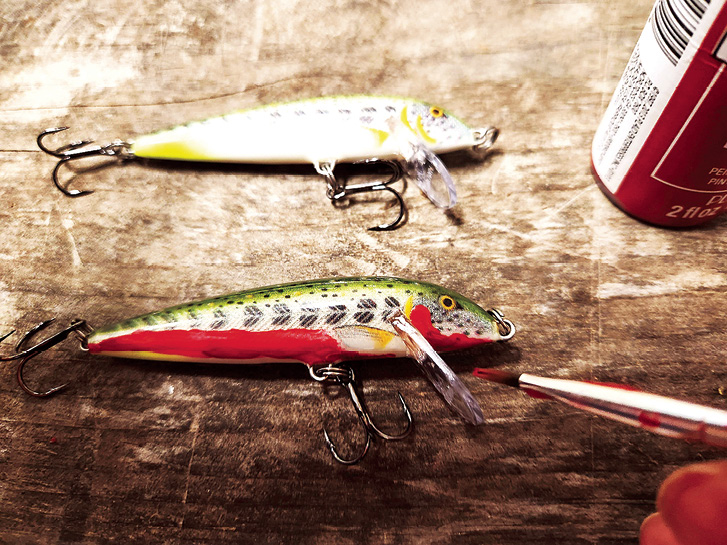We are still in the grip of winter here in the north, even if it hasn’t been quite as frosty as normal. Some anglers love getting out on the ice, drilling holes and jigging spoons. However, there are just as many (maybe even more) anglers who pine for the appearance of open water and getting out the canoe or boat. For these people, winter is a prime time to tinker with tackle. It’s fun, passes the time, and can increase both your catch, and number of opportunities, when the lake is open.
Here are a few tackle tinkering ideas.
Change the Hooks
I’m consistently amazed at how many people use dull, mangled or rusty hooks when they fish. When working as a fishing guide, I almost always check a customer’s lure or fly before they cast it. About 50 percent of the time, the hook point is not as sharp as it should be. This can usually be fixed with a hook hone. Yet, I still see an alarming number of hooks that are as dull as a hoe, or so rusty that just a little pressure snaps them off. Changing out old hooks is the easiest way to improve your hooking percentage on lures.
There are a few high-quality hook options, but Gamakatsu, VMC, Mustad, and Owner all make replacement treble hooks for spoons, crankbaits, and spinners. Match the hook size you are replacing on your lure with the ones you buy. At times I will replace a factory lure hook with one a size bigger. I nearly always do this if the fish are larger predators such as chinook salmon or pike. Adding coloured replacement trebles to a spoon, spinner or crankbait also adds to the overall sexiness of the lure. I like red hooks, but green, glow, and blue hooks are also available. If you like to fish topwater plugs for bass, adding a treble dressed with some bucktail to the back of the bait can really increase the appeal. The bucktail pulses under the water as the plug gurgles on the surface.
If you are changing the hooks, you might as well look over the split ring you are attaching the hook to as well. Any split ring that looks stretched out, rusty or otherwise compromised should be replaced too. Components like these are generally available at sporting goods stores where fishing tackle is bought. If you don’t see them on the shelf, always ask your local dealer if they can order some.

Paint Night!
There was a time when fishing lures were quite plain jane. A red and white spoon was about as exciting as it got, with plain silver and brass blades being standard. These days, a quick gander at a fishing store will reveal lures in all colours of the rainbow. However, most of us have a lot of older lures in the box that could use a little sprucing up. Maybe that old red and white spoon needs a touch up? Or maybe those old plain jane spoons from the 80s could use a dash of colour. A few years ago, I went through some old boxes and dug out a few trout spoons that needed a little love. After adding new hooks, I busted out some craft store paint. Adding a line of red or blue along the edge of an old silver spoon really made a difference. Old spinners with dull or plain blades can also be updated with some dots of red, blue or glow paint. A few years ago, when I couldn’t find any Little Joe style spinners with white blades, I painted my own. Some white paint on the top of silver blades solved the problem. Even some newer lures can get a little added dazzle with just the smallest amount of colour. The #9 Countdown Rapala is an all-time favourite lure of mine for any number of species. Yet, I’ve found adding a little extra red to the gill area of the Countdown, and even along the belly, can increase its productiveness—especially in places where red belly dace is a common forage fish.
Some anglers on the Great Lakes and in areas where herring are found will paint large eyes on crankbaits and spoons. The thinking is that predator fish focus on eyes when they look for food. It’s worth a try if you chase salmon, lake trout, pike or muskie.
Tape and Stickers
Another cool trick is to add a chunk of reflective tape to a lure like a spoon or spinner. This reflective tape comes in a variety of patterns and colours, including some very realistic looking scale patterns. My favourite tape is pearl or silver, as it has the subdued flash of a wounded baitfish. Most of the tape comes in squares or sheets that need to be cut to size. You then take the piece of tape, remove the backing, and add it to the lure. The difference reflective tape can make is often dazzling. Another cool tackle trick is to add small lead-based stickers to the bottom of floating or neutrally buoyant crankbaits. These stickers were sold under a variety of brand names, including “suspend-dots.” These weighted stickers were popularized by tournament bass and walleye anglers who wanted to get lures a little deeper, but without using sinkers. I’ve not seen them for sale as often in recent years, but I have a little surplus supply that I still dip into from time to time. Getting a crankbait to run a little bit deeper can make a huge difference when fish are light shy or used to seeing lures acting a certain way.
These are just a few of the ways you can improve your existing lure supply with some simple additions. If you’ve been looking for something simple and crafty to do this winter, tackle tinkering may be the thing for you.




